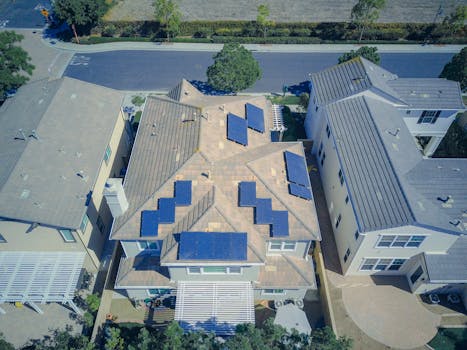“Elevate Energy: Harnessing the Sun with Innovative Floating Solar Mounting Systems.”
Solar mounting systems for floating solar farms represent an innovative approach to harnessing solar energy by utilizing bodies of water, such as lakes, reservoirs, and coastal areas. This emerging technology addresses land scarcity issues while maximizing solar energy generation efficiency. Floating solar installations reduce water evaporation, improve panel cooling, and minimize ecological disruption compared to traditional ground-mounted systems. As the demand for renewable energy grows, floating solar farms are gaining traction globally, offering a sustainable solution that integrates seamlessly with existing water infrastructure and contributes to energy diversification and environmental conservation.
Advantages Of Floating Solar Mounting Systems
Floating solar mounting systems represent a significant advancement in renewable energy technology, particularly in the context of solar farms. As the demand for clean energy continues to rise, these innovative systems offer a multitude of advantages that make them an attractive option for both energy producers and environmental advocates. One of the most compelling benefits of floating solar mounting systems is their ability to utilize otherwise unused water surfaces, such as reservoirs, lakes, and even coastal areas. This not only maximizes land use but also helps mitigate land competition, particularly in densely populated regions where space is at a premium.
Moreover, floating solar installations can enhance energy production efficiency. Water bodies naturally cool the solar panels, which can lead to improved performance compared to traditional land-based systems. This cooling effect can increase the overall energy output, allowing for a higher return on investment. Additionally, the reflective nature of water can reduce the amount of dust and debris that accumulates on the panels, further enhancing their efficiency and reducing maintenance costs. As a result, floating solar farms can generate more electricity per unit area than their terrestrial counterparts.
Another significant advantage of floating solar mounting systems is their potential to reduce water evaporation. In regions where water scarcity is a pressing concern, covering a portion of a water body with solar panels can significantly decrease evaporation rates. This not only conserves water resources but also helps maintain the ecological balance of the surrounding environment. By reducing evaporation, floating solar farms can contribute to the sustainability of local ecosystems, making them an environmentally friendly option for energy generation.
In addition to their environmental benefits, floating solar systems can also provide economic advantages. The construction and maintenance of these systems can create jobs and stimulate local economies. Furthermore, the integration of floating solar farms into existing water infrastructure can lead to cost savings in terms of land acquisition and development. By utilizing existing water bodies, developers can avoid the high costs associated with land-based solar farms, making floating solar a more economically viable option in many cases.
Transitioning to floating solar technology also aligns with global efforts to combat climate change. As countries strive to meet their renewable energy targets, floating solar farms can play a crucial role in diversifying energy sources and increasing overall capacity. This technology can be particularly beneficial in regions with limited land availability or where land use conflicts are prevalent. By harnessing the power of the sun on water surfaces, nations can accelerate their transition to a low-carbon future.
Furthermore, floating solar mounting systems can be designed to coexist with other water-based activities, such as fishing and recreational boating. This dual-use potential allows for the simultaneous generation of renewable energy while preserving the existing uses of water bodies. As such, floating solar farms can foster community acceptance and support, as they do not necessarily disrupt local economies or lifestyles.
In conclusion, the advantages of floating solar mounting systems are manifold, encompassing environmental, economic, and social dimensions. By leveraging unused water surfaces, enhancing energy efficiency, conserving water resources, and promoting job creation, floating solar technology stands out as a promising solution in the quest for sustainable energy. As this emerging technology continues to evolve, it holds the potential to transform the landscape of renewable energy generation, paving the way for a cleaner, more sustainable future.
Key Design Considerations For Floating Solar Farms
As the demand for renewable energy continues to rise, floating solar farms have emerged as a promising solution to harness solar power while minimizing land use. However, the design of these systems is critical to their efficiency, longevity, and overall success. One of the primary considerations in the design of floating solar farms is the choice of mounting systems. These systems must be robust enough to withstand environmental challenges such as wind, waves, and temperature fluctuations while ensuring optimal solar panel orientation for maximum energy capture.
First and foremost, the buoyancy of the mounting system is essential. Floating solar farms typically utilize pontoons or other buoyant structures to keep solar panels above the water’s surface. The design must ensure that these structures can support the weight of the solar panels, along with any additional equipment such as inverters and transformers. Moreover, the buoyancy must be carefully calculated to accommodate varying water levels, which can fluctuate due to tides, rainfall, or evaporation. This adaptability is crucial for maintaining the stability and integrity of the solar array over time.
In addition to buoyancy, the mounting system must also consider the materials used in its construction. Given the aquatic environment, materials must be resistant to corrosion and degradation caused by water exposure, particularly in saltwater conditions. High-density polyethylene (HDPE) and aluminum are commonly used due to their durability and resistance to corrosion. Furthermore, the choice of materials can impact the overall weight of the system, which in turn affects buoyancy and stability. Therefore, a careful balance must be struck between material strength and weight to ensure the longevity of the floating solar farm.
Another key design consideration is the anchoring system. Floating solar farms must be securely anchored to prevent drifting or capsizing, especially in areas prone to strong winds or waves. Various anchoring methods can be employed, including mooring lines, dead weights, or even submerged anchors. The choice of anchoring system will depend on the specific environmental conditions of the installation site, as well as the size and configuration of the solar array. Proper anchoring not only enhances stability but also ensures that the solar panels maintain their optimal orientation towards the sun, maximizing energy production.
Moreover, the layout of the solar panels is a critical aspect of the design. The arrangement must take into account factors such as shading from nearby structures or vegetation, as well as the spacing between panels to allow for maintenance and cleaning. Additionally, the layout should facilitate water circulation beneath the panels, which can help mitigate algae growth and maintain water quality. By optimizing the panel layout, designers can enhance energy efficiency while also promoting ecological balance in the surrounding aquatic environment.
Finally, the integration of monitoring and maintenance systems is vital for the long-term success of floating solar farms. Regular monitoring of performance metrics, such as energy output and system integrity, can help identify potential issues before they escalate. Furthermore, maintenance access must be considered in the design phase to ensure that technicians can safely and efficiently service the solar panels and associated equipment. By prioritizing these design considerations, floating solar farms can become a sustainable and effective solution for harnessing solar energy while preserving valuable land resources. As this technology continues to evolve, it holds the potential to significantly contribute to the global transition towards renewable energy.
Environmental Impact Of Floating Solar Mounting Solutions
The environmental impact of floating solar mounting solutions is a critical consideration as this technology gains traction in the renewable energy sector. Floating solar farms, which utilize bodies of water for solar panel installation, present a unique opportunity to harness solar energy while minimizing land use. This innovative approach not only addresses the growing demand for clean energy but also offers several environmental benefits that merit attention.
One of the most significant advantages of floating solar mounting systems is their ability to reduce land competition. As urbanization and agricultural needs continue to encroach upon available land, the deployment of solar panels on water surfaces alleviates pressure on terrestrial ecosystems. By utilizing reservoirs, lakes, and other water bodies, floating solar farms can generate substantial amounts of electricity without disrupting valuable habitats or agricultural land. This strategic use of space is particularly beneficial in densely populated regions where land scarcity poses a challenge to renewable energy development.
Moreover, floating solar systems can enhance water quality and reduce evaporation. The presence of solar panels on water surfaces can create a shading effect, which helps to lower water temperatures and inhibit the growth of algae. This is particularly important in areas where water bodies are prone to eutrophication, a process that can lead to oxygen depletion and harm aquatic life. By mitigating these issues, floating solar farms not only contribute to energy generation but also promote healthier ecosystems in the surrounding environment.
In addition to improving water quality, floating solar mounting solutions can also play a role in carbon sequestration. Water bodies naturally absorb carbon dioxide, and the installation of solar panels can further enhance this process by reducing the amount of sunlight that penetrates the water surface. This reduction in light can lead to decreased photosynthesis in certain aquatic plants, which may help to balance carbon levels in the water. Consequently, floating solar farms can contribute to climate change mitigation efforts by supporting carbon management strategies.
Transitioning to the construction and maintenance of floating solar systems, it is essential to consider their ecological footprint. The materials used in these mounting solutions are often designed to be durable and resistant to corrosion, which minimizes the need for frequent replacements and reduces waste. Furthermore, many manufacturers are increasingly focusing on sustainable materials and practices, ensuring that the environmental impact of production is kept to a minimum. This commitment to sustainability extends to the end-of-life phase of the solar panels, where recycling and repurposing initiatives are becoming more prevalent.
However, it is crucial to acknowledge that floating solar farms are not without their challenges. The potential impact on local wildlife, particularly aquatic species, must be carefully assessed. Studies are ongoing to evaluate how these installations affect fish populations and other marine organisms. By conducting thorough environmental impact assessments and implementing monitoring programs, stakeholders can ensure that floating solar farms coexist harmoniously with local ecosystems.
In conclusion, the environmental impact of floating solar mounting solutions is largely positive, offering a sustainable alternative to traditional land-based solar farms. By utilizing water bodies for energy generation, these systems not only conserve valuable land resources but also contribute to improved water quality and carbon management. As the technology continues to evolve, it is imperative that developers prioritize ecological considerations to maximize the benefits of floating solar farms while minimizing any potential adverse effects. This balanced approach will be essential in advancing the role of floating solar technology in the global transition to renewable energy.
Future Trends In Floating Solar Technology
As the world increasingly turns its attention to renewable energy sources, floating solar technology is emerging as a promising solution to meet the growing demand for sustainable power generation. This innovative approach involves installing solar panels on bodies of water, such as lakes, reservoirs, and even oceans, thereby maximizing land use while minimizing environmental impact. As we look to the future, several trends are shaping the development and implementation of floating solar farms, particularly in the realm of solar mounting systems.
One of the most significant trends is the advancement of solar mounting systems specifically designed for floating applications. These systems are engineered to withstand the unique challenges posed by aquatic environments, including wave motion, wind forces, and potential corrosion from water exposure. Manufacturers are increasingly focusing on materials that offer durability and resistance to harsh conditions, such as high-density polyethylene and aluminum alloys. This shift not only enhances the longevity of the solar installations but also reduces maintenance costs, making floating solar farms more economically viable.
Moreover, the integration of advanced technology into floating solar mounting systems is becoming more prevalent. For instance, the incorporation of smart sensors and monitoring systems allows for real-time data collection on performance metrics, environmental conditions, and structural integrity. This data-driven approach enables operators to optimize energy production and promptly address any issues that may arise, thereby enhancing the overall efficiency of floating solar farms. As these technologies continue to evolve, we can expect to see even more sophisticated solutions that improve the reliability and effectiveness of floating solar installations.
In addition to technological advancements, there is a growing emphasis on the scalability of floating solar farms. As energy demands rise, the ability to deploy large-scale solar installations on water bodies becomes increasingly important. Floating solar systems can be designed to accommodate various sizes, from small community projects to extensive utility-scale operations. This flexibility allows for a broader range of applications, making it possible to harness solar energy in regions where land is scarce or unsuitable for traditional solar farms. Consequently, we are likely to witness a surge in floating solar projects across diverse geographical locations, further diversifying the renewable energy landscape.
Another trend that is gaining traction is the integration of floating solar farms with other renewable energy technologies. For example, hybrid systems that combine floating solar with wind turbines or energy storage solutions are being explored to enhance energy generation and reliability. By leveraging the complementary nature of these technologies, operators can create more resilient energy systems that can better meet fluctuating demand. This holistic approach not only maximizes the use of available resources but also contributes to a more sustainable energy future.
Furthermore, as governments and organizations worldwide commit to ambitious climate goals, the regulatory landscape surrounding floating solar technology is evolving. Policymakers are beginning to recognize the potential of floating solar farms as a viable solution for achieving renewable energy targets. This shift is likely to result in increased funding opportunities, incentives, and streamlined permitting processes, which will further accelerate the adoption of floating solar technology.
In conclusion, the future of floating solar technology is bright, driven by advancements in solar mounting systems, integration with other renewable technologies, and supportive regulatory frameworks. As these trends continue to unfold, floating solar farms are poised to play a crucial role in the global transition to sustainable energy, offering a unique solution to the challenges of land scarcity and environmental impact. With ongoing innovation and investment, floating solar technology is set to become a cornerstone of the renewable energy landscape in the years to come.
Q&A
1. **What are floating solar farms?**
Floating solar farms are solar power installations that are mounted on bodies of water, such as lakes, reservoirs, or oceans, utilizing floating platforms to support solar panels.
2. **What are the advantages of solar mounting systems for floating solar farms?**
Advantages include reduced land use, improved cooling of solar panels (which can increase efficiency), reduced evaporation of water bodies, and minimal environmental impact on terrestrial ecosystems.
3. **What materials are commonly used in floating solar mounting systems?**
Common materials include high-density polyethylene (HDPE), aluminum, and stainless steel, which are chosen for their durability, corrosion resistance, and ability to withstand harsh marine conditions.
4. **What are the challenges associated with floating solar mounting systems?**
Challenges include the need for robust anchoring systems to withstand wind and waves, potential impacts on aquatic ecosystems, and the complexity of maintenance and installation in water environments.
Conclusion
Solar mounting systems for floating solar farms represent an innovative approach to harnessing solar energy by utilizing water surfaces, thereby minimizing land use and reducing evaporation. This emerging technology offers several advantages, including increased efficiency due to cooler water temperatures, reduced algae growth, and the ability to generate power in areas where land is scarce or expensive. As the demand for renewable energy grows, floating solar farms are becoming a viable solution for sustainable energy production, contributing to energy diversification and environmental conservation. Overall, the development and implementation of solar mounting systems for floating solar farms signify a promising advancement in the renewable energy sector, with the potential to significantly impact global energy strategies.




